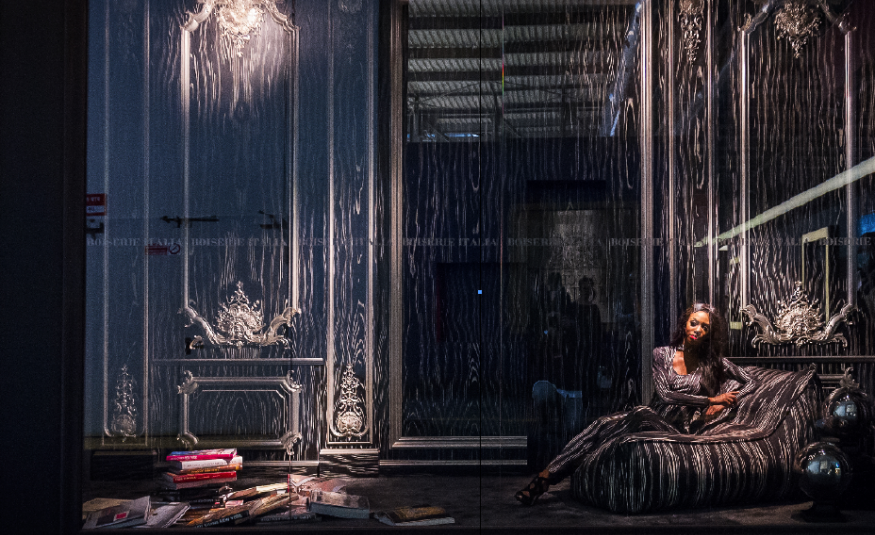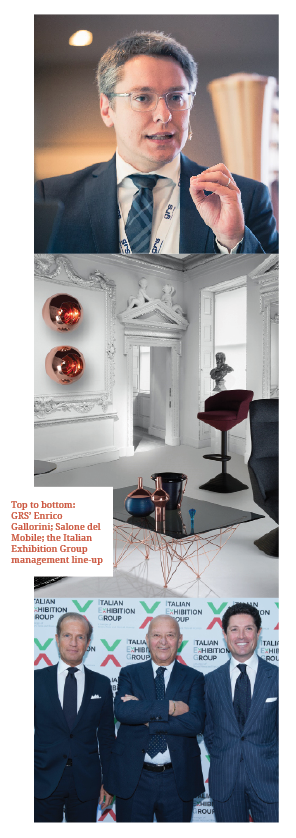Italian exports are adored worldwide, but the nation’s exhibition market has been slow to translate domestic appeal into geo-cloned global exhibitions, until now
‘Passionate’ was an epithet used liberally on EW’s recent Italian tour, to describe the enthusiastically curated content, design and unique atmosphere of Italy’s shows.
This ambiance, often evolved from century’s old local expertise, makes for a flourishing national scene, albeit one that is fragmented into specialist regions.
It is easy to become passionate about Italy’s most famous exports: cars, fashion, food, furniture and jewellery. And the exhibitions that represent them can be equally high specification.
This unwavering attention to detail has made Italy Europe’s second largest manufacturing centre, behind Germany, and the eighth largest economy globally in terms of GDP.
Its regional rivalries provide the passion necessary to refine the quality of its products, but the divisions fail to serve Italy’s exhibition industry as a whole.
Enter Italian Exhibition Group Spa (IEG): a business formed at the backend of 2016 following a merger between Italian trade show organisers Rimini Fiera Spa and Fiera di Vicenza Spa.
IEG is Italy’s first example of a merger between trade show companies, forming the country’s top player in terms of directly organised shows. Its ambition from the outset is to be listed in the Stock Exchange and act as the ‘unifying element’ to bring together other Italian trade show organisations.
The general feeling at IEG is that venues have turned the exhibition industry into a real estate business.
While many venues think about size, IT, upgrading, logistics and infrastructure, IEG note that there’s only a very small investment on the actual products: the shows themselves.
Matteo Marzotto, vice president of Italian Exhibition Group Spa, says: “The merger between Rimini Fiera and Fiera di Vicenza is an historic precedent and an absolute forerunner, as it creates a trade show entity that, we believe, will be a further unique aggregation pole and we have a concrete development impetus for a true Italian trade show system.
“IEG is the result of our vision for a high-standing industrial project that will serve the very best production chains. It will be a driver for their internationalisation, as well as creating a powerful and attractive market for leading companies the world over.”
IEG aims to be a company based on products, not on ‘walls’, one that looks to Italy, Europe and the world, not just its local area.
Breaking this culture was Fiera di Vicenza Spa’s challenge and, to succeed, it needed to make partnerships with other nationally and internationally-minded venues.
After an extensive search, it emerged that Rimini, a city near Bologna famous for tourism, was, serendipitously, undergoing a similar pursuit.
Rimini set up an architecturally striking venue just 15 years ago. There had been a huge effort in bringing in trade shows, and a spate of hotel builds and good connections to neighbouring cities was another bonus.
Rimini also boasted a finely honed collection of shows, including the strongest show in the world linked to ice cream and shows targeted at markets including coffee, chocolate and renewable energy.
The presidents of Vicenza and Rimini set up a meeting, agreeing it would be mutually beneficial to mix their strong points: Vicenza’s track record with international markets, and Rimini’s expertise in exhibitor value propositions and national demand.
IEG was formed to make the shared proposition much bigger. Its plan is to invest in the venues, and attract the most important shows and brands to Italy, then geo-clone them globally.
IEG aims to go public in spring 2018, and become a group working for Italy, gaining investments to approach international markets with its proposition of combined international and local expertise.
Plans are now underway to build the group’s portfolio and strengthen its existing 63 shows.
“A lot of shows at various venues around Italy need repositioning,” Marzotto says, and a reinvestment to make them strong again.
Before the merger, Vicenza and Rimini had already been organising shows in Milan and Rome using the venues of other companies. Internationally, they had shows in San Paulo, in the US with Reed Exhibitions, as well as in Dubai with DV Global Link, a joint venture with Dubai World Trade Centre. IEG now seeks to go where the market has demand, worldwide.
IEG’s portfolio already covers a large number of industries, leading to connections with most of the show organisers in Italy. They are also on good terms with competitors, and seek to bring some of their competitors’ shows into the group in the long term.
For IEG, the close proximity of many major Italian cities should be a major selling point and an impetus for unified thinking. There is just two hours by train separating Venice, Milan, Turin, Rome, Bologna and Verona. By contrast, cities like Hong Kong and London can take two hours just to get from one side to another.
Germany was cited by Marzotto as a globally thinking marketplace. Their shows are often highly international in both visitors and exhibitors.
Others familiar with IEG’s vision agree, including Enrico Gallorini, CEO – GRS Research & Strategies, who says there are shows in Germany that have more Italian exhibitors than German exhibitors. “At IEG, they think in order to be the hub for industries at a European level, they have to gain exhibitors and visitors from all over the world. The only way to reach that target is to invest in the product, look outside of the box, look at digital strategy. It’s more of a revolution in the mind of the venues.
“The reorganisation taking place throughout the global exhibition market and the challenges faced by the system led Italian operators to rethink their structures and business models. Italian production inherently needs exhibitions. Generally speaking Italian companies are small to medium-sized, and IEG not only seek to understand them not only at a business level, but in terms of networking and professional growth,” he adds.
“The industry is widely raising the standards of its organisational and commercial process, with increasingly international benchmarks and contaminations from other sectors. IEG is one of the most important examples of that.”
This vision, however, does not mean providing generic cookie cutter shows: IEG are keen to bring an Italian flavour – the aforementioned ‘passion’ – to the events.
The goal is to deliver shows in the Italian way, meaning they will be orientated towards social and welcoming behaviour, with attention to experience, food and beverages and lifestyle. High attention is also traditionally paid to the quality of the design in order to match the business environment .
IEG’s vision is one shared by many in the Italian exhibition industry.
Fiera Milano has also been embracing new models to take advantage of the wider Milanese infrastructure and harness the appeal that goes with being in a thriving, cultural city.
TUTTOFOOD, held as part of a new ‘Food Week’ in Milan, is exemplary of Fiera Milano’s concept for future exhibitions. The B2B show, organised by Fiera Milano from 8-11 May 2017, is designed as a showcase for presenting products to the national and international markets.
Corrado Peraboni, CEO at Fiera Milano, talks to EW from his office overlooking the expansive Fiera Milano grounds: “We are expanding our current events to involve the whole city. Food Week is inspired by events like Design Week, which evolved naturally across 30 years, but we are looking to achieve that kind of culture much faster. We created a committee to help bring together schools, street markets, and venues to bring in countries not necessarily interested in a traditional exhibitions,” says Peraboni.
“As a venue we are well placed to bring many organisations together. We have brands so well known globally that traditional b2b exhibitions are not necessarily of concern. Big Italian brands of food, for example, want direct contact with the public, to convey messages concerning nutrition and so on. By bringing in the wider city, we are able to involve this kind of company and extend the reach of our exhibitions,” he continues.
This vision, like IEG’s, was inspired by competing internationally. “We don’t have the same flight service as, say, Frankfurt, but we do provide a different way to present your company. Before, many companies were afraid to have too many distractions outside an exhibition but now they see the extraordinary opportunities,” says Peraboni.
Perhaps the vanguard of Italy’s megashow market however is Salone del Mobile, billed as the most well-known furniture show in the world. The event is held in Milan attracting 1,300 exhibitors, with over 350.000 professional visitors.
Speaking from his impeccably designed office, with art celebrating more than 56 years of ‘Salone’, general manager Marco Sabetta tells EW there is much to gain from passionately focusing on one vertical market. “We are owned by Italian wood and furniture organisation Federlegno Arredo Group, so our focus is on one vertical,” he says.
“Every year we invest a lot in traditional communication and in installations from artists. For example we made a short video with Gomorrah director Matteo Garrone, dedicated to classic furniture. It’s about listening to your industry and caring about your customer. Nike, for example, comes to Salone to feel what is happening, to feel the colours and the latest trends,” says Sabetta.
With turnover at more than 40m Euros, the show’s reach is impressive, given that the financial return from one show is not far off the turnover of many smaller organisers who might have hundreds of shows.
Elsewhere in Italy, Fiera Parma is also embracing a more international outlook. “We are very inspired by international models, and we have a long-term vision, inspired by the likes of Cologne Messe,” says CEO Antonio Celle. “Cibus exhibition attracts top brands because they are proud of the show and the Made In Italy appeal. As Parma is the capital for food we have the environment to create great culinary shows, and these can be appreciated around the world.”
As Italian Exhibition Group looks to further represent Italy on a global stage, a look at some of Italy’s most successful exhibitions is a reminder that the country is already doing so much right. EW







